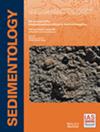Effects of clay and organic matter on calcareous nannofossil ooze erodibility
IF 2.8
2区 地球科学
Q1 GEOLOGY
引用次数: 0
Abstract
ABSTRACT Bottom current activity has been responsible for the formation of a multitude of erosional and depositional features recorded in chalk. Advanced knowledge on the mobility and transport of unlithified calcareous nannofossil ooze by bottom currents is increasingly important not only for understanding the deposition of ancient chalk, but also for modelling the behaviour of modern pelagic carbonate sediments. Whereas the erosional behaviour of very pure calcareous nannofossil ooze has recently been investigated, the effect of organic matter and clay minerals on the erosional behaviour of calcareous nannofossil ooze is as yet unquantified. The results of the present study are based on laboratory flume studies utilizing chalk ooze with varying concentrations of smectite clay (1 to 30 wt. %), two types of organic matter and bed porosity. Phytoplankton ( Pavlova lutheri ) was used as a proxy for particulate marine organic matter, and xanthan gum as a proxy for extracellular polymeric substances. The results show a significant decrease in nannofossil ooze mobility with increasing content of clay or marine organic matter. Organic matter is found to reduce erodibility at much lower concentrations than clay minerals at porosities equivalent to those of the sea floor. At lower porosities, corresponding to some depth below the sea floor, organic matter and clay minerals are less effective in bed stabilization. This suggests that clay minerals and especially organic matter will affect the likelihood of initiation of severe erosion on the sea floor, whereas their inhibiting effect will decrease as erosion scours progressively deeper into the sediment column. The effect of extracellular polymeric substances is more complex than marine organic matter, probably due to detachment of large aggregates from the bed and resulting increase in bed roughness. The choice of organic matter in sedimentological experiments may lead to significant differences in sediment behaviour and should therefore involve careful consideration.粘土和有机质对钙质纳米化石软泥可蚀性的影响
海底洋流的活动导致了白垩中大量侵蚀和沉积特征的形成。关于未岩化的钙质纳米化石软泥在海底洋流作用下的移动和搬运的先进知识,不仅对了解古代白垩的沉积,而且对模拟现代远洋碳酸盐岩沉积的行为越来越重要。虽然近年来对纯钙质纳米化石软泥的侵蚀行为进行了研究,但有机质和粘土矿物对钙质纳米化石软泥侵蚀行为的影响尚未量化。本研究的结果是基于实验室水槽研究,利用含不同浓度蒙脱石粘土(1%至30%)的白垩软泥,两种类型的有机物和床孔隙度。以浮游植物(Pavlova lutheri)作为海洋颗粒有机物的代表,黄原胶作为胞外聚合物物质的代表。结果表明,随着粘土和海相有机质含量的增加,纳米化石软泥的流动性显著降低。研究发现,在孔隙度与海底相当的情况下,有机质浓度远低于粘土矿物浓度,从而降低可蚀性。在孔隙度较低的地方,相当于海床以下一定深度,有机质和粘土矿物对地层稳定的效果较差。这表明粘土矿物,特别是有机物会影响海底开始严重侵蚀的可能性,而随着侵蚀逐渐深入沉积物柱,它们的抑制作用会减弱。细胞外聚合物质的作用比海洋有机物的作用更为复杂,这可能是由于大团聚体从床上脱落,从而导致床的粗糙度增加。在沉积学实验中,有机物的选择可能会导致沉积行为的显著差异,因此应仔细考虑。
本文章由计算机程序翻译,如有差异,请以英文原文为准。
求助全文
约1分钟内获得全文
求助全文
来源期刊

Sedimentology
地学-地质学
CiteScore
8.20
自引率
11.40%
发文量
94
审稿时长
6-12 weeks
期刊介绍:
The international leader in its field, Sedimentology publishes ground-breaking research from across the spectrum of sedimentology, sedimentary geology and sedimentary geochemistry.
Areas covered include: experimental and theoretical grain transport; sediment fluxes; modern and ancient sedimentary environments; sequence stratigraphy sediment-organism interaction; palaeosoils; diagenesis; stable isotope geochemistry; environmental sedimentology
 求助内容:
求助内容: 应助结果提醒方式:
应助结果提醒方式:


